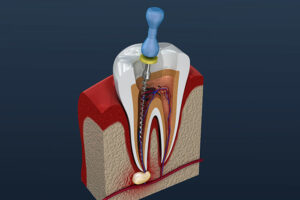
The root canal is a well-known dental procedure. It’s fodder for many jokes and set-ups in comedy movies and television. In particular, root canals are famous for being uncomfortable if not painful. But is any of that true? For all of their fame, root canals are equally misunderstood. We’re here to correct some of that misinformation by addressing the core question: what is a root canal? In particular, what happens during a root canal, what can the patient expect during a root canal, and what happens after? There’s a lot to go over, but we’ll try to make it as clear and easy to follow as possible.
Let’s start with what a root canal is and what it’s designed to fix. In its most basic form, a root canal is the removal of the tooth’s pulp–the soft tissue surrounded by the harder outer layers of dentin and enamel. Root canals are intended to repair damage to the tooth which has resulted in the pulp getting infected or damaged to the point that it needs to be replaced. This generally happens when the tooth is cracked, broken, or has a cavity that’s run deep into the pulp. This can happen to any tooth in the mouth, requiring a root canal in order to correct the problem.
Now that we understand that, let’s look at the actual process of a root canal procedure. Root canals may happen in a single visit to the dentist or may require several office visits, depending on the severity of the situation and the needs of the patient. In general, however, the process goes something like this:
- First, an opening is made either in the crown of the molar or on the back of the front tooth. The exact size and location will depend on the individual patient.
- Second, the dentist removes the damaged or infected pulp in a procedure known as a pulpectomy. After the pulp has been removed, the space left behind is cleaned and widened to the correct shape before being filled.
- At this point, the dentist may put a temporary filling in place if the root canal is going to take place over more than one office visit. This temporary filling will protect the open tooth from further damage or infection until the root canal is complete.
- The next step involves filling the now-empty tooth. If necessary, the temporary filling is removed and the tooth is filled with a rubbery substance called gutta percha. Sometimes a metal or ceramic post is added for structural support, and then the whole thing is sealed with dental cement.
- After the tooth has been filled, a crown or other dental prosthetic is put in place to cover and protect it. This gives the restored tooth the feel and function of a natural tooth.
That’s it! At this point the root canal is complete. Most patients need a day or so to recover from their root canal, but after that, they may generally resume normal activities–the repaired tooth functions just like a natural one. With proper care, a tooth restored with a root canal should last a lifetime.
We hope this helps you understand what a root canal is a bit better. They’re generally neither as scary nor as painful as they’re made out to be–again, most patients recover fully in a day or two. Whether you need a root canal or just a routine exam and cleaning, we’re here to help you attain the best oral health possible. Get in touch today and we’ll make an appointment!




